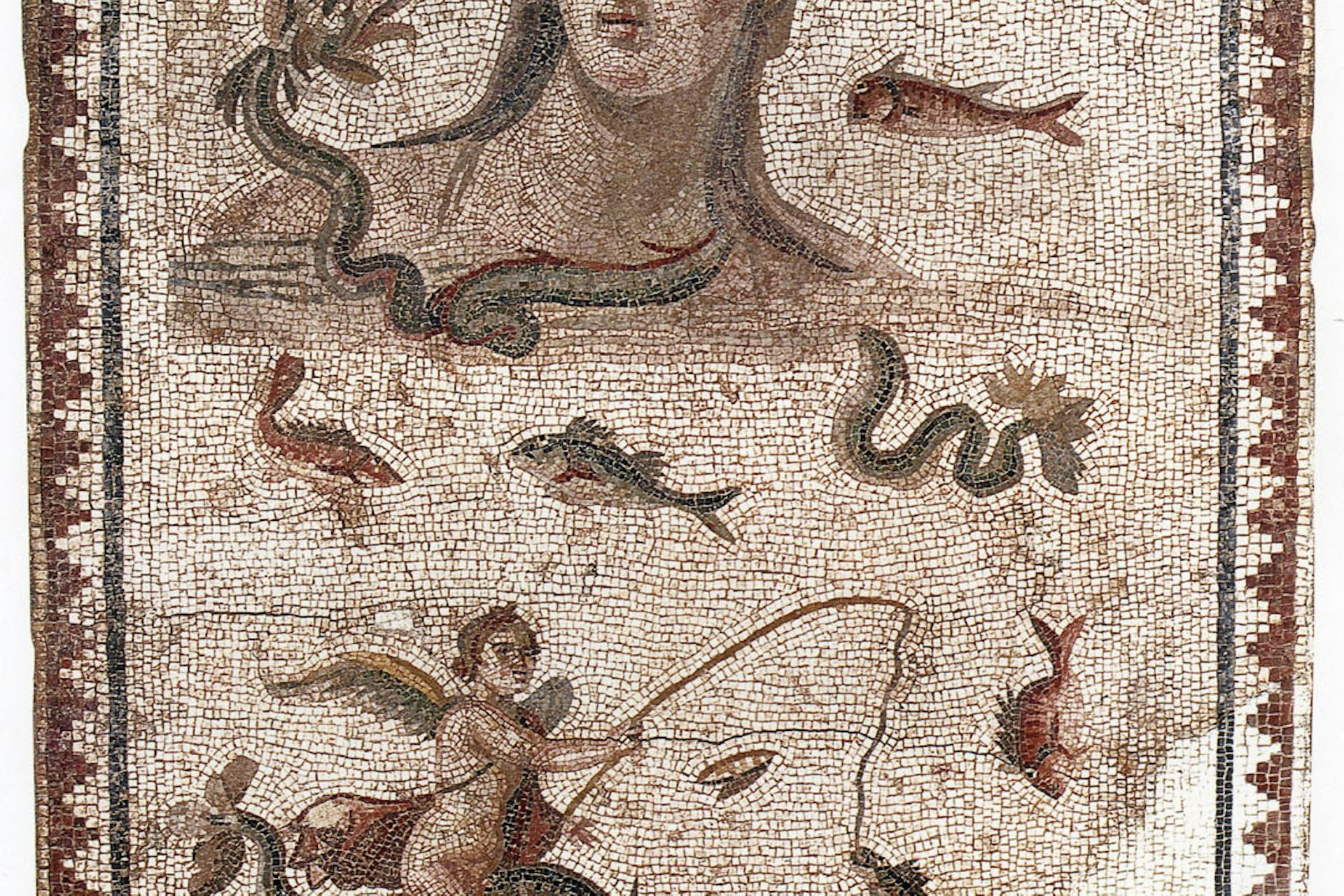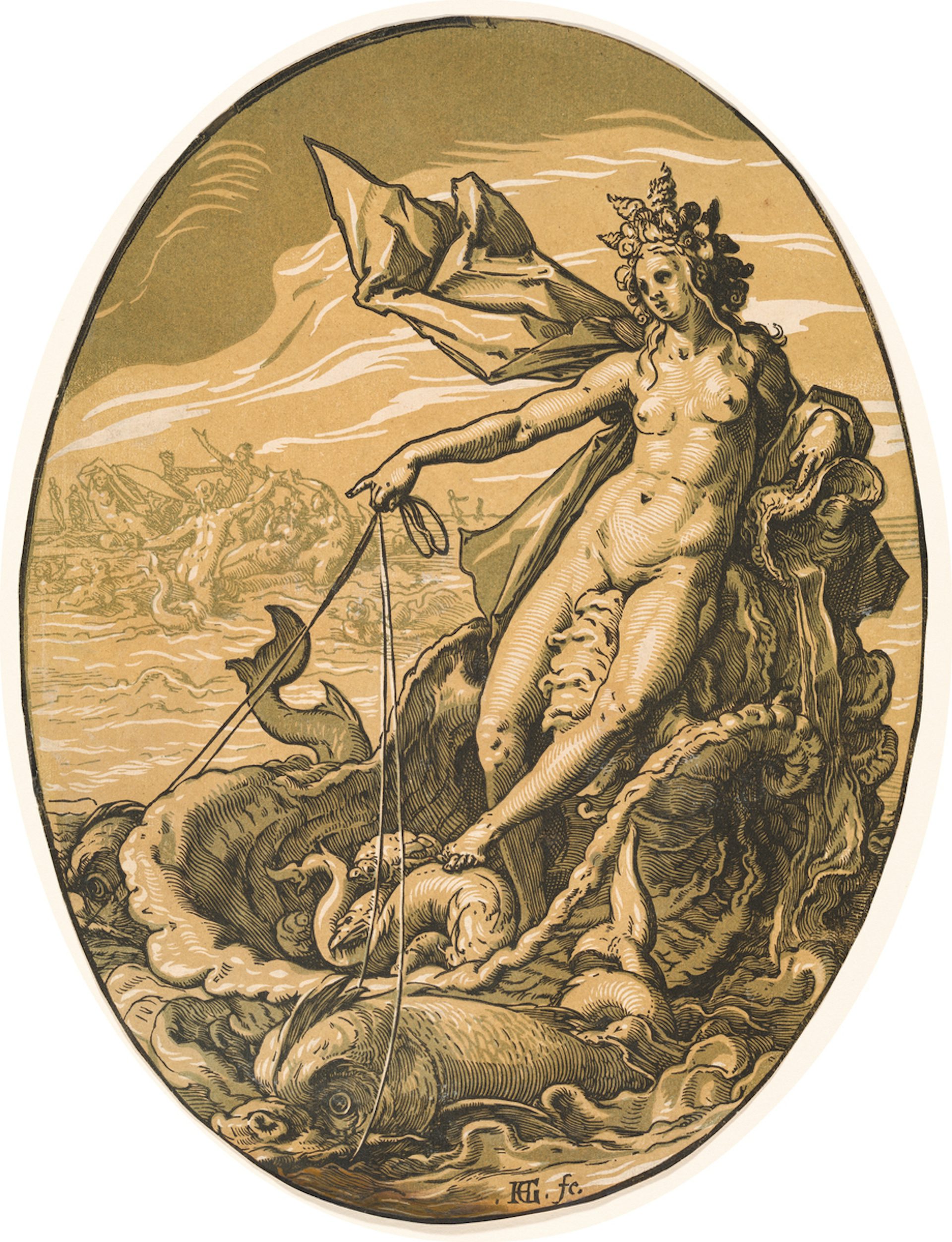Tethys

Fragment of floor mosaic depicting Tethys in a marine background from Harbiye, Turkey (ca. 250-275).
Baltimore Museum of ArtPublic DomainOverview
Tethys, the daughter of Gaia and Uranus, was one of the original twelve Titans of Greek mythology. In later life she married her brother Oceanus and gave birth to innumerable children, including the Oceanids and all the rivers of the world. Despite reproducing so prolifically, Tethys remained an obscure deity; she was not generally worshipped by the Greeks.
Etymology
The origin of the name “Tethys” (Greek Τηθύς, translit. Tēthýs) remains elusive. In antiquity, the philosopher Plato suggested a fanciful etymology for the name, seeing it as a compound of the Greeks words διαττώμενον (diattṓmenon, “strained”) and ἠθούμενον (ēthoúmenon, “filtered”). Plato claimed that this was appropriate because Tethys was the goddess of springs—which are, indeed, “strained” and “filtered.”[1]
Unsurprisingly, Plato’s creative etymology has not been accepted by modern scholars. It is possible that Tethys’ name may be connected to the Greek word τήθυον (tḗthyon), which refers to a sea squirt and is in turn likely related to the Proto-Indo-European *dʰeh₁(y)- (“to suck”).[2]
Other scholars have argued that there is a connection between the Greek Tethys and the Babylonian Tiamat, also a primordial sea goddess. In this case, Tethys was probably originally a Near Eastern goddess who was later imported to Greece.[3]
Pronunciation
English
Greek
Tethys Τηθύς (translit. Tēthýs) Phonetic
IPA
[TEE-this] /ˈti θɪs/
Attributes
Due to her relationship with Oceanus and the aquatic nature of her many children, Tethys was closely associated with bodies of water. In the early stages of Greek religion, Oceanus and Tethys may have been even more important. In Homer’s Iliad, for example, Hera calls Tethys “mother” and says that it is Oceanus “from whom the gods are sprung.”[4] These words may have been merely figurative, or they may have represented an alternative cosmogony in which Tethys and Oceanus, not Gaia and Uranus, were the originators of the world.[5]
According to the Orphics, a religious group that stressed the importance of asceticism and ritual in attaining a blissful afterlife, Oceanus and Tethys were indeed the first divine couple, born a generation before the Titans.[6] In traditional Greek religion, however, they were subordinate to Zeus and the Olympians.

Tethys by Hendrick Goltzius (1588–1590). Tethys is shown on a seashell chariot pulled by sea creatures.
National Gallery of Art, Washington DCPublic DomainIn the few sources that mention her, Tethys is consistently portrayed as a maternal figure. In art, she was usually depicted together with her husband Oceanus or other gods, often with small wings growing out of her head.
Family
A daughter of the primordial deities Gaia and Uranus,[7] Tethys was one of twelve Titans, the others being Coeus, Crius, Cronus, Hyperion, Iapetus, Thea, Rhea, Themis, Mnemosyne, Phoebe and Oceanus. Tethys’ siblings also included the horrific one-eyed Cyclopes and the equally detested Hecatoncheires—monsters with a hundred hands each.
Tethys took her brother Oceanus as her husband. Together, they gave birth to the rivers of the world as well as the three thousand nymphs known collectively as the Oceanids. Their children were thus too numerous to be named:
there are three thousand neat-ankled daughters of Ocean who are dispersed far and wide, and in every place alike serve the earth and the deep waters, children who are glorious among goddesses. And as many other rivers are there, babbling as they flow, sons of Ocean, whom queenly Tethys bare, but their names it is hard for a mortal man to tell, but people know those by which they severally dwell.[8]
Family Tree
Mythology
Tethys is briefly mentioned in Hesiod’s eighth century Theogony, an epic describing the divine order of the cosmos as the Greeks understood it. Hesiod introduces Tethys as a child of Gaia and Uranus and later elaborates on her relationship with Oceanus and their copious offspring.
For reasons that are unclear, Tethys and Oceanus sided with the Olympians during the Titanomachy, a ten-year conflict between the gods and the Titans. In Homer’s Iliad, Zeus’ wife Hera even claims that Tethys was her foster mother when she was young. In Hera’s words, Oceanus and Tethys “lovingly nursed and cherished me in their halls, when they had taken me from Rhea, what time Zeus, whose voice is borne afar, thrust Cronos down to dwell beneath earth and the unresting sea.”[10]
Tethys was also sometimes mentioned in connection with Callisto—a lover of Zeus who was transformed into a bear. When Callisto died, she underwent yet another transformation, this time becoming the constellation Ursa Major, the Great Bear. All the other stars, it was said, bathed in the waters of Oceanus as they cycled through the heavens—all except Ursa Major. This was because Hera hated Callisto for having had an affair with her husband Zeus. She therefore asked either Tethys or Oceanus (there are different versions) to forbid Ursa Major from bathing in the waters of Oceanus with the other stars.[11]
Pop Culture
Tethys appeared in 1998’s Hercules and Xena – The Animated Movie: The Battle for Mount Olympus, where she was represented as a water deity with an appetite for destruction. Portrayed as an ardent supporter of the Titans’ cause, the film’s Tethys attempts to kill Aphrodite.
Tethys has also lent her name to one of the many moons orbiting the planet Saturn.